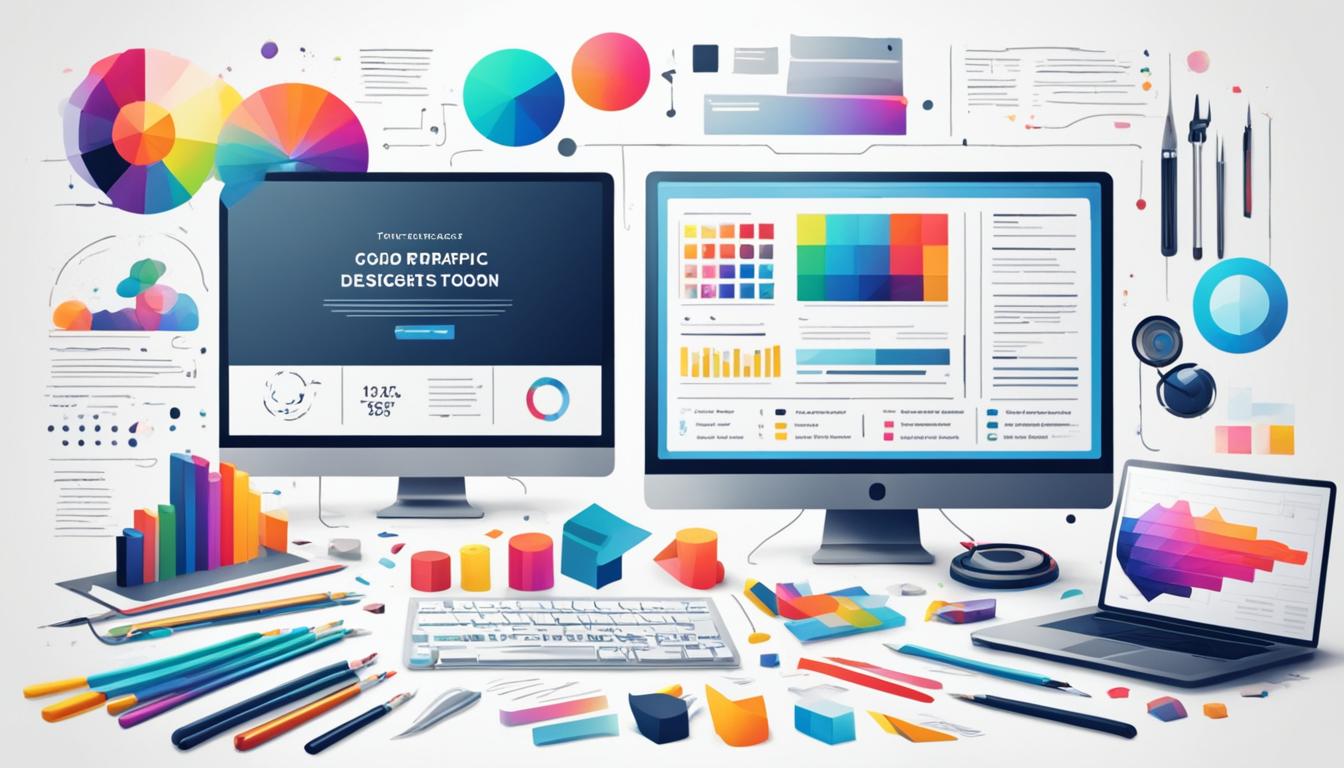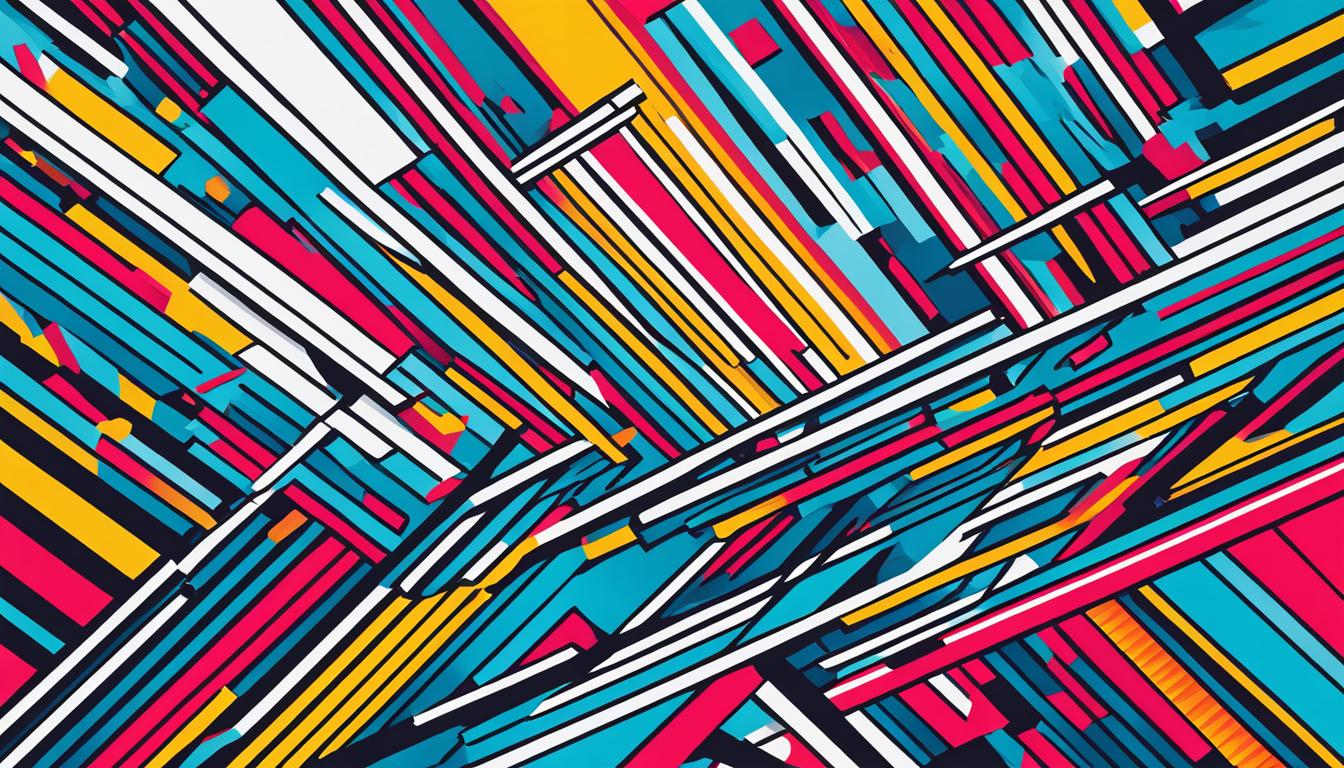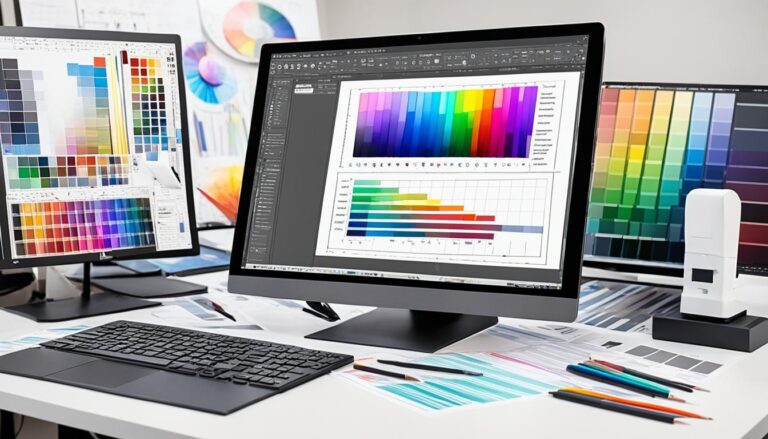Graphic Design Degrees Explained – Education Guide
A graphic design degree is a gateway to a world of visual communication and design. Whether you’re passionate about creating stunning visuals or you want to explore the creative aspects of advertising, a graphic design degree can equip you with the knowledge and skills you need to succeed in this dynamic field.
Graphic design programs, also known as communication design or design programs, are available at different educational levels. From associate degrees to master’s degrees, you can choose the level of education that suits your career goals and aspirations.
An associate degree in graphic design is a solid foundation that typically takes around two years to complete. It covers the fundamental principles and basics of design.
A bachelor’s degree in graphic design is the most common choice for aspiring graphic designers. It takes about four to five years to complete and offers a more comprehensive understanding of visual communication. Bachelor’s degree programs are available as either a Bachelor of Arts (BA) or a Bachelor of Fine Arts (BFA).
For those seeking to deepen their expertise, a master’s degree in graphic design is an option worth considering. These programs typically take one to two years and offer specialized knowledge in areas such as branding, typography, and multimedia design.
Online graphic design degrees have surged in popularity due to their flexibility and accessibility. Whether you choose to pursue a degree on-campus or online, both options can provide you with valuable skills and insights into the world of graphic design.
According to the US Bureau of Labor Statistics (BLS), a bachelor’s degree is often considered the entry-level education required for many arts and design occupations, including graphic designers and art directors. So if you’re looking to start a career in graphic design, a degree in this field can be a game-changer.
Types of Graphic Design Courses
When pursuing a bachelor’s degree in graphic design, students can expect to take a variety of courses. These courses provide a comprehensive understanding of graphic design principles and techniques, as well as practical skills in various design areas. Some common types of graphic design courses include:
- Introduction to Graphic Design: This course serves as an introduction to the field of graphic design, covering the basics of visual communication and design principles.
- Digital Communication: In this course, students learn about designing for digital platforms and explore strategies for effective digital communication.
- Design Thinking: Design thinking focuses on problem-solving and innovation through a human-centered approach. This course helps students develop creative and strategic thinking skills.
- Art History: Understanding the history of art and design is essential for graphic designers. This course explores different art movements and their influence on contemporary design.
- Color Theory: Color plays a crucial role in graphic design. This course delves into color psychology, color harmony, and the practical application of color in design.
- Typography: Typography is the art of arranging type. This course covers the fundamentals of type design, letterforms, and typographic principles.
- Motion Design: In this course, students learn how to create visually engaging animations and motion graphics using industry-standard software.
- Production Design: Production design focuses on the technical aspects of graphic design, such as prepress techniques, file preparation, and print production.
- Web Design: Web design explores the principles of designing user-friendly and visually appealing websites. Students learn about layout, navigation, and responsive design.
- User Experience (UX): UX design focuses on creating engaging and intuitive experiences for users. This course covers user research, wireframing, and prototype development.
- Information Design: Information design involves presenting complex information in a visually clear and accessible manner. This course explores data visualization and information architecture.
- Media Management: Media management focuses on organizing, categorizing, and distributing digital assets effectively. Students learn about content management systems and digital asset management tools.
These are just a few examples of the diverse range of courses available in a graphic design program. Each course plays a crucial role in developing the skills and knowledge needed to excel in the field of graphic design.
Tuition and Career Opportunities
Earning a bachelor’s degree in graphic design involves a significant financial and time commitment. Tuition costs vary based on the institution and can have an impact on the overall investment in your education. On average, public universities charge around $10,740 per year for graphic design programs, while private universities have an average annual tuition of $38,080.
When considering the cost of tuition, it’s important to weigh the value of the education and the potential return on investment that a graphic design degree can offer. Graduates with a strong foundation in graphic design principles and techniques have access to a wide range of career opportunities in various industries.
Career Opportunities
A graphic design degree opens the door to a multitude of creative career paths. Graduates can pursue opportunities as graphic designers, art directors, brand strategists, web designers, user experience designers, illustrators, and more. With the increasing demand for digital and visual communication, the graphic design industry continues to offer promising career prospects.
Graphic design is an essential element in today’s business landscape, providing companies with the ability to communicate visually and connect with their target audience effectively. As a graphic designer, you have the opportunity to shape the visual identity of brands, create impactful marketing materials, and contribute to the overall success of businesses.
Moreover, graphic designers often have the flexibility to work as freelancers or in-house for design agencies, marketing departments, media companies, and other organizations. This versatility allows graphic designers to explore different industries and collaborate on diverse projects.
While graphic design offers exciting career prospects, it’s important to note that success in this field relies not only on education but also on continuous learning, honing your skills, and staying up to date with industry trends and technologies. Building a strong portfolio and gaining practical experience through internships or freelance work can greatly enhance your employment prospects.
In conclusion, pursuing a bachelor’s degree in graphic design requires a financial investment, but it opens doors to a dynamic and creative career with numerous opportunities for growth and personal development.
Conclusion
Pursuing a degree in graphic design equips individuals with the necessary skills and knowledge to embark on a creative career path. Whether through traditional bachelor’s degree programs or online learning options, students can develop a strong foundation in graphic design principles and techniques. The industry offers diverse career opportunities with competitive salaries, allowing graphic design graduates to work in various industries and for renowned companies.
A graphic design career allows individuals to unleash their creativity and passion for visual communication. By combining artistic skills with technical expertise, graphic designers have the opportunity to shape the visual identity of businesses and organizations. From designing logos and brand identities to creating engaging marketing materials, graphic designers play a crucial role in conveying messages effectively.
With a graphic design degree, professionals can explore exciting roles such as graphic designer, art director, web designer, user experience designer, and more. Graphic design careers are dynamic and fast-paced, offering an ever-evolving landscape for creativity and innovation. So, if you have a passion for visual communication and a desire to pursue a creative career, a graphic design degree may be the perfect choice for you.
FAQ
What is a graphic design degree?
A graphic design degree signifies in-depth knowledge about visual communication and design.
What are graphic design programs also known as?
Graphic design programs are also known as communication design or design programs.
What are the different levels at which a graphic design degree can be pursued?
A graphic design degree can be pursued at the associate, bachelor’s, or master’s level.
How long does it take to complete an associate degree program in graphic design?
Associate degree programs usually take about two years to complete.
How long does it take to complete a bachelor’s degree program in graphic design?
Bachelor’s degree programs take about four to five years to complete.
How long does it take to complete a master’s degree program in graphic design?
Master’s degree programs usually take one to two years to complete.
Are online graphic design degrees available?
Yes, online graphic design degrees are also available and offer flexibility in learning.
What level of education is often considered the entry-level for graphic design occupations?
According to the US Bureau of Labor Statistics (BLS), a bachelor’s degree is often considered the entry-level education for many arts and design occupations such as graphic designer and art director.
What are some common courses in a bachelor’s degree program in graphic design?
Some common courses in a bachelor’s degree program in graphic design include introduction to graphic design, digital communication, design thinking, art history, color theory, typography, motion design, production design, web design, user experience, information design, and media management.
How much does a graphic design degree cost?
The cost of tuition for a graphic design degree varies depending on the institution, with public universities averaging $10,740 per year and private universities averaging $38,080 per year.
How long does it take to complete a graphic design degree?
Many graphic design programs are designed to be completed in four years, but the actual time to complete the degree can be influenced by factors such as full-time versus part-time status, major changes, and credit transfers.
What career opportunities are available with a graphic design degree?
With a graphic design degree, individuals can find employment in diverse industries and work for renowned companies.
Is a graphic design degree a good choice for someone interested in a creative career?
Yes, pursuing a degree in graphic design can provide individuals with the necessary skills and knowledge to enter a creative career path.










